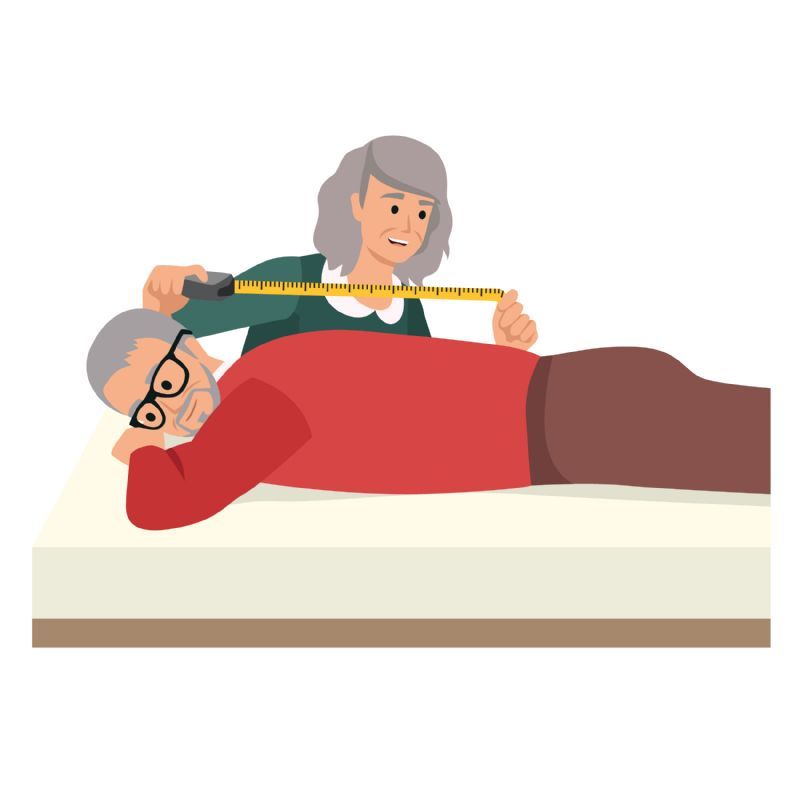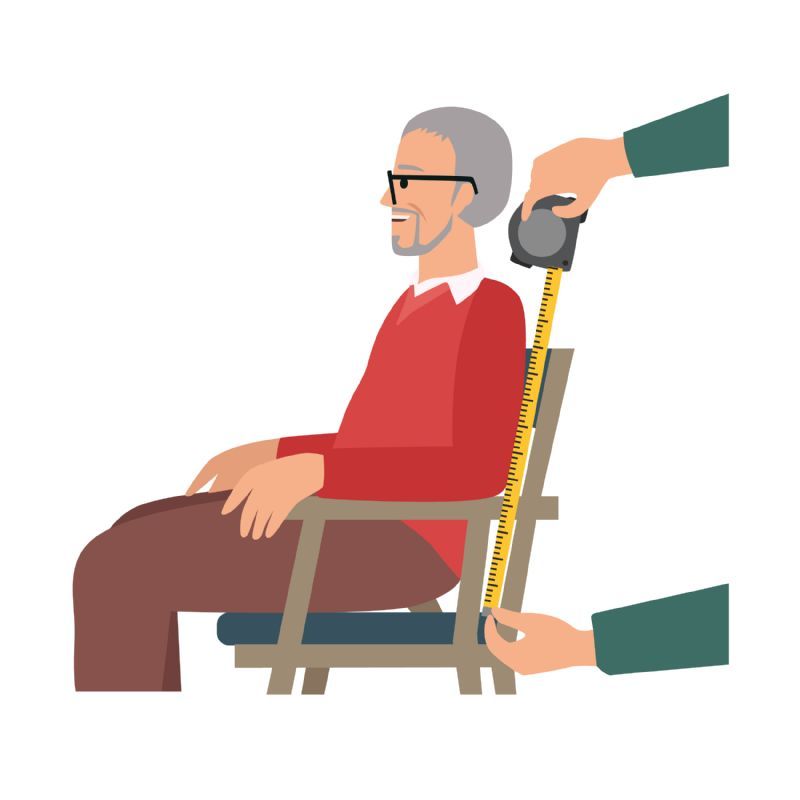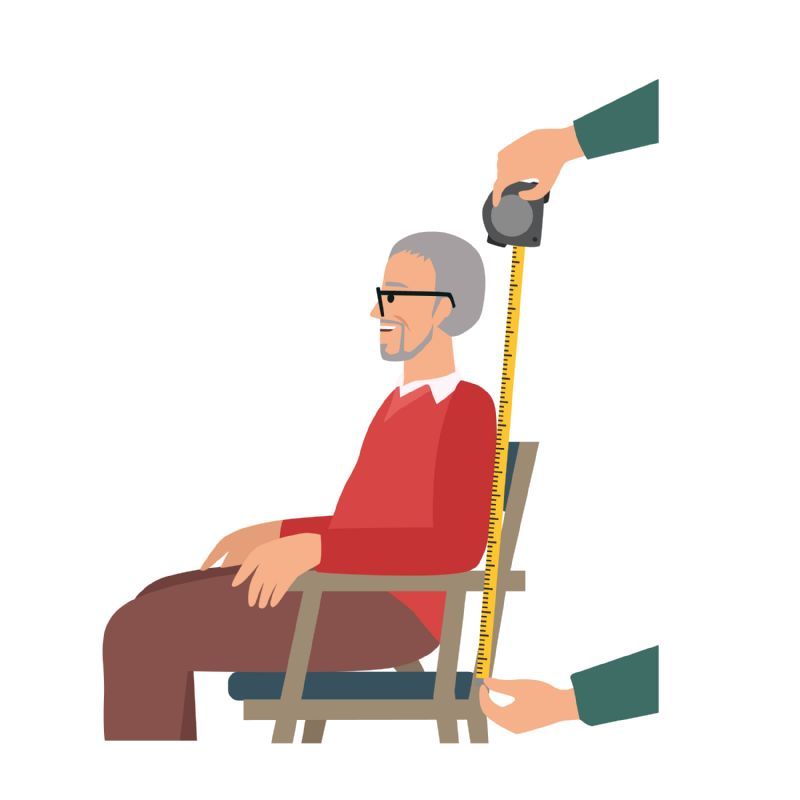 Written by Brittany Ferri, OTR/L
Written by Brittany Ferri, OTR/L
If you care for someone who relies on a mechanical lift to get around, you know how important the right sling is. This guide will help you size a universal sling that will safely cradle your loved one. If you use an ill-fitting sling, your loved one is not only at risk of being uncomfortable, but they can also sustain injuries. For example, a sling that is too small can cause circulation concerns, bruising, and skin tears. An overly large sling will not conform to the person’s body in the right way, leading them to slip out and potentially injure themselves from falling.
We are offering this article so home lift users can find the right size in popular brands. This article is merely a guide to make the selection process easier, so remember there are many other factors involved in choosing the right sling, including weight distribution, bodily deformities, and medical conditions. Health concerns such as hip pain, shoulder pressure discomfort, limited range of motion, and spinal/back deformities all have an impact on how a sling will fit. Additionally, surgeries such as amputations change a person’s weight distribution (also known as their center of gravity), making it important to find an appropriate sling. If you have more questions after reading this guide, we urge you to speak with your doctor to find the best size for your needs.
If your loved one already has a sling, this makes the process slightly easier because you should have an idea of whether to use the same brand or find a different one. In the event that your loved one wants to stick with the brand they have, think about whether or not the current sling fits.
You can determine if the sling is a good fit by looking at how it supports your loved one. A proper sling should support the torso and thighs without letting the buttocks slip down through the sling’s opening. If it is difficult to help your loved one assume this position, the Joerns brand is just one sling that offers markings to help someone put it on the right way. They offer two dots that fall on your loved one’s spine, so you should be sure the sling goes the entire length of their back and keeps their spine aligned. Once the sling is on, take a look at the material. If it is smooth and flat, this is a sign that it’s a good fit.
If you’re still unsure how helpful your current sling is, use the sizing guide on the website to see what category your loved one’s weight falls into. The rule of thumb is to remain with the same brand if you are satisfied with your current sling. If you’re interested in purchasing another sling brand, use the steps below to find the best size. There are slight variations between brands, so don’t assume the size will remain the same as your current sling.
If you don’t already have a sling, no need to fret! You should use a hard measuring tape to record your loved one’s overall height, weight, width, and torso height. These are the basic measurements you will use to compare to each brand’s sizing guide.

This is one of the most crucial measurements, since some brands offer sizing based solely on this criteria. It’s important to get an accurate weight using a standard scale. Do not guess your loved one’s weight or take the figure that was recorded at their last doctor’s visit! If their recorded weight falls between two sizes, it’s usually best to opt for the smaller sling, since this will keep your loved one more secure. For example, if your loved one weighs 190 pounds, it’s best to opt for the 180-pound sling rather than the 200-pound sling.

Option 1: A person’s height can be measured in two ways, depending on the user's level of mobility. The first method is by having them stand up straight against a wall and placing a mark on the wall behind them (using a pencil). Then, take a tape measure and measure the distance from the ground to that point on the wall.

Option 2: If your loved one is unable to assume this position, you can also measure their height while they are lying on the bed. The user needs to lay on their side, making sure that their back is straight and their legs are not bent. You will need to measure from their head to their toes, in incremental measurements. Start by measuring from the top of their head, holding the measuring tape with one hand, and extending your reach as far as you can (without it being uncomfortable to you!). You can place your finger on their body where you left off, and make that your starting point for your next measurement. Repeat this process until you have measured from head to toe. It might be helpful to write down the measurements as you take them.

Option 1: This measurement is not quite as important as the others, but it still should be taken. This involves measuring the widest points on the person’s body. This horizontal measurement can be taken while they are seated or lying down. For males and children, the widest point on their body is usually their shoulder width. This figure is taken by measuring the distance from the end of one shoulder to the end of the other.

Option 2: For some females, their hips will be the widest part of their body. If measuring the hips, measure from the outside of one hip to the outside of the other hip. Some people mistakenly take the hip circumference, which measures the distance around both hips.

A person’s torso height can be measured while they are sitting. You can take a measuring tape and record the distance from the base of their buttocks to the highest point of their shoulder. If your loved one has difficulty assuming a seated position, you can measure this while they are laying down. Roll them on their side and measure from the prominent hip bone to the very top of their shoulder. This measurement is most important for standard, medium-back slings without head support.
If you need a sling with head support, be sure to read our next section.

Most universal slings are medium-back and do not come with head support, so it’s important to gauge whether or not your loved one needs this feature. Someone might benefit from head support if they have trouble keeping their head upright on their own or if they have involuntary movements that frequently change their posture. If the sling is not for one particular person and is intended for use within a nursing facility or hospital, it’s best to have a sling with some form of head support for those patients who need it. Additionally, slings with head support are more comfortable for the user, as they can relax while being transported.
If you want head support, you will need a high-back sling. The measurement is very similar to torso height, except you are measuring from the base of the buttocks to the top of the head. The best way to get this figure is by sitting the person down and measuring from their tailbone to the top of their head.
A divided leg sling, also known as a U-sling, is ideal for toileting since it allows more freedom of the legs and can be removed more easily once the patient is in place. There are no specific measurements to take for this style of sling, but it is a simpler, more comfortable style that most caregivers choose regardless of a patient’s needs.
We mentioned before that amputations change a person’s center of gravity, which impacts the type of sling they need. There are slings, such as the Molift Easy Amputee 4-Point RgoSling, specifically designed for individuals who have had lower body amputations. These slings usually offer a smaller seat opening with full back support and a clip-on vest to keep someone balanced and properly distribute their weight as they are moved. This is one style of sling that offers closed leg openings to provide users with more security than the divided leg openings offer. The measurements will vary based on the specific type of amputation. For example, individuals with a below knee amputation should have a sling that extends to the knee area. Users who have had an above knee amputation would benefit from a sling that goes to the bottom of the longest stump. To accommodate for these changes, you should take measurements from the top of the head to the gluteal fold. It is also recommended to measure between the two ends of the widest part of the person’s body.
Most bariatric slings can accommodate between 550 and 600 pounds, so caregivers should be aware of whether or not their loved one needs this type of sling before ordering. Other features remain the same, so torso height and other measurements will be taken the same way. You can find a range of bariatric slings here.
There are many size guides that display the sling's length, width, and height. If you are a Caregiver, then disregard this type of guide. This guide is designed for healthcare professionals looking for more specific sizing information. This can help therapists and other providers fit custom slings to specific types of patients.

The universal slings by Joerns are measured by weight. You might recognize this company by one of its most popular brands: Hoyer. Most Joerns slings pair with loop spreader bars, which allow the sling to be attached to the lift itself at two separate points. The six colored loops offer more balance and stability for any user, so caregivers can help patients achieve just the right angle. These slings offer a range of helpful features, including added padding, positioning handles to assist caregivers in moving the patient, and dignity straps that help keep a person’s legs closed.
As we mentioned before, this brand offers markings on the sling to assist with placement and adjustment. There are tabs on the back that should align with the person’s shirt label and tailbone. If you are looking for another Joerns sling to replace your existing one, you can use this to help you take measurements for the new one. Joerns also offers a Mesh Sling for Bathing.

Universal Handicare Slings require caregivers to take height and weight measurements. These slings have color-coded loops and two lateral caregiver handles to assist with repositioning as needed. Most brands offer the standard divided leg slings, since these offer the most comfort and versatility for self-care tasks such as toileting and dressing. Handicare offers both divided leg and closed leg slings. Two front-facing straps cross to ensure users are securely seated when they need to be. Several other straps are available on other parts of the sling to allow for more adjustability. Depending on the sizing and angle, this sling offers users various seated and semi-reclined positions and even has the option of a commode opening for those who need it. Handicare slings are compatible with loop spreader bars, which allow the sling to be attached to the lift itself at two separate points for even weight distribution.

Etac slings are a part of the larger brand Molift. Etac slings are fitted according to a user’s weight, width, and torso height. Universal Etac Slings are four-point slings with divided leg closure. For users who need additional support, Etac also offers the Universal Sling with HighBack and closed leg to give more padding to the back and head. The majority of the Etac slings fit with loop spreader bars to assist with weight distribution. These slings all offer a flip-up labeling system so that caregivers can follow the right transfer steps with ease. Some slings offer caregiver handles to help with positioning but Etac has application pockets, which allow caregivers to demonstrate better ergonomics by using their entire hand to adjust the sling rather than their fingers. Color-coded loops allow for optimal adjustability according to how the user wants to be positioned. One thing to be aware of is that this company is based in Sweden, meaning whoever orders the sling should first change the user’s measurements from inches to centimeters with this handy converter.

BestCare is another brand of slings that work best with six-point bars since many of their designs are six-point slings. Universal BestCare Slings are measured by a user’s weight capacity. These slings can also be used with a four-point or a two-point bar, but the six-point is advised for the best distribution. BestCare has standard slings and padded slings, both offered with and without head support. Each style of these slings has three straps so caregivers can help adjust.

Most Invacare slings are four-point slings that are compatible with hanger bars and cradle bars. They also offer the Universal Invacare Sling with high back and closed leg as well as a divided leg closure sling for those who want added comfort. All of these slings are measured by weight capacity. Invacare slings are all color-coded by size, so caregivers can find the best fit for the user. This brand offers a full-body sling, two full-body slings with commode openings to assist with toileting, and a full-body toileting sling equipped with a belt. They also offer standing slings and transfer slings to be used with sit-to-stand lifts.

Amico slings, more commonly known by the GoBasic or GoLift brand, are measured by torso height, shoulder width, and hip width. Universal Amico Slings are all compatible with a two-point carry bar. These slings have between four and six points, depending on the specific style. Amico offers toileting slings, sit-to-stand slings, transfer-oriented slings, and slings without head support. They stand apart from others by also offering slings specially designed for people who need help readjusting within bed and those who need to be lifted directly from laying down. Many of their slings have head control, but there are several styles that come without it.

Arjo slings are sized according to the user’s weight and torso height. These slings have four straps and are best used in conjunction with a cradle bar. Arjo's general-purpose slings are high-back and offer head support. You will need to measure the torso height for high-back slings (which includes the measurement of the head). These slings have clips that help them better attach to the Arjo cradle for easy patient movement. Most Arjo brand slings are only compatible with Arjo products, which means this is a brand of slings that is not compatible with other lifts. They offer slings for children, bariatric slings, and slings for patients with lower body amputations. Arjo also makes walking slings to assist partially mobile patients in rehabilitation and other slings that are compatible with sit-to-stand lifts.
This article is intended only as a guide, so please be aware that a range of unique patient characteristics will impact the sizing and fit of any given sling. If you are unsure about any of the above options or have more specific questions, please consult your doctor. If you want more guidance in identifying the type of sling that is best for your loved one’s needs, take a look at How to Choose the Best Patient Lift Sling. You can shop all of our patient lift slings and learn more at Caregiver University.
>> Shop Patient Lift Slings <<
Brittany is an occupational therapist who has worked in a variety of rehab facilities. She has always expressed an interest in patients’ internal motivation for therapy and the use of assistive devices, which led her to pursue a PhD in Integrative Mental Health. This research-based training has also led her to develop her writing career to educate patients of all ages on how to improve their health. Brittany has published four books, written over 300 articles, and has been quoted in media outlets such as WebMD, Healthline, and NBC News.